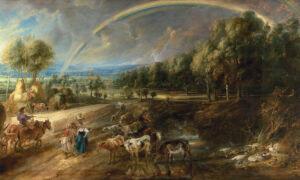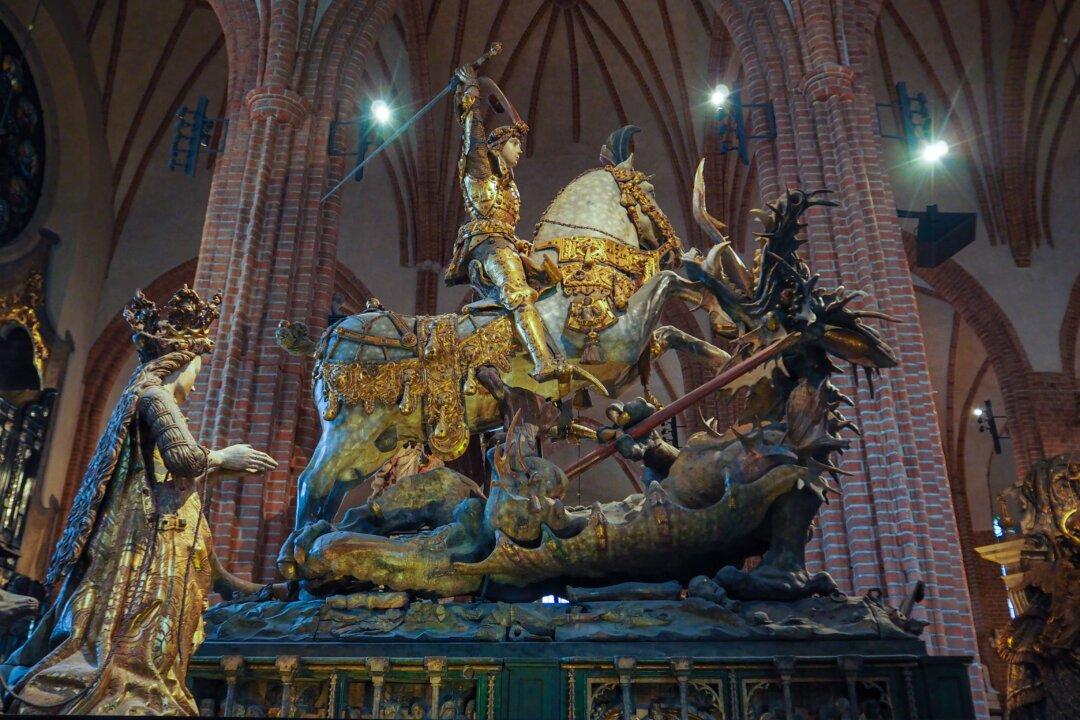Fine art fans may be surprised to learn that Spain’s Prado National Museum in Madrid holds the largest collection of works by Flemish master Peter Paul Rubens. The majority of them come from the collection of King Philip IV (1605–65), who Rubens often painted for. One of Spain’s greatest masters, Diego Rodríguez de Silva y Velázquez was influenced by Rubens.
Rubens painted some 1,400 artworks, although some experts say as many as 1,800. Rubens’s prolific output wouldn’t have been possible without his workshop.The Prado’s new exhibition “Rubens’s Workshop” shows how European artists worked together to create masterful works. It provides a fascinating insight into Rubens’s painting process in the European workshop tradition.

Through more than 30 works, the museum’s senior curator of Flemish Painting and Northern Schools, Alejandro Vergara, shows how Rubens divided work in his workshop to fulfill commissions while preserving the quality and style of his paintings. Exhibition visitors can see the different types of works Rubens created, including paintings by his hand alone and those that were painted by his assistants to varying degrees. Among the paintings are Rubens’s collaborative works with his workshop artists, notably Anthony van Dyck (1599–1641), Frans Snyders (1579–1657), and Jacques Jordaens (1593–1678), who all became successful artists.
Rubens
Rubens (1577–1640) was born in Siegen, now in Germany. His Calvinist father had once been a lawyer and alderman in Antwerp. He had fled the Spanish Netherlands (now Belgium) with his wife and children to escape religious persecution in 1568.After Rubens’s father died in 1587, the family returned to Antwerp. His mother raised Rubens in her Catholic faith, and he received a classical education.
Around the age of 14, Rubens took an apprenticeship with landscape painter Tobias Verhaecht, a relative. After a year, he apprenticed for four years with history painter Adam van Noort. He then entered the workshop of the most famous artist in Antwerp at the time, Otto van Veen, who was dean of the painters’ guild of St. Luke.

In van Veen’s workshop, Rubens learned painting as a humanistic endeavor by studying the humanities (“studia humanitatis”), including Latin and Ancient Greek literatures, grammar, rhetoric, history, poetry, and moral philosophy.
Rubens traveled to Italy at the beginning of the 17th century, immersing himself in studying not only contemporary Renaissance Italian art but ancient art and philology. From then on, he began a serious art collection.
The Artist’s Workshop
Rubens ran one of the largest and most successful workshops of his day. According to the exhibition book, from the founding of his workshop on Oct. 15, 1598, until his death on May 30, 1640, Rubens created an average of three paintings per month—from small sketches to monumental paintings. His workshop paintings made his art affordable.
Rubens created most paintings in Antwerp in a canal house now known as the Rubenshuis Museum. French painter and critic Roger de Piles (1635–1709) wrote in his 1681 book “La Vie de Rubens” (“The Life of Rubens”): “Rubens bought a large house in Antwerp, rebuilt in the Roman style, and embellished the interior to make it suitable for a great painter and a great amateur of beautiful things. A garden adjoined the house. … Between the courtyard and the garden, he built a round hall like the Pantheon that is in Rome … into which daylight entered only through the oculus at the centre of the dome.”
In his replica Pantheon, Rubens displayed his vast sculpture collection. He and his assistants painted mainly in a room about 28 feet by 43 feet, with a nearly 22-foot-high ceiling.The replica of Rubens’s workshop allows exhibition visitors a sneak peek into the master’s world. The curatorial team have made it seem as if Rubens has just left his workshop for a breath of fresh air and inspiration. “Mercury and Argus” rests on his easel. An assistant has defined the shapes and volumes of the composition in matte paint, and Rubens has just begun to breathe color and life into the work, with fresh paint on Argus’s head and cloak. One can almost smell the heady scents of turpentine and linseed oil wafting through the air.

A maulstick (a stick used to support the artist’s painting hand) rests on the easel, and a primed paint palette and paint-stained cloth hangs from the bottom. On a nearby table, a workshop assistant has prepared seashells of paint, terra-cotta pots of paint and pigments, and glass vessels full of water and binding agents. Paintings, picture frames, and canvases in various states are stacked against the walls. Above a grinding stone and mortar and pestle, rolled-up drawings poke out of a box. For classical inspiration, bronze and plaster reproductions of ancient sculptures are on display.

The European Workshop Tradition
Renaissance masters almost always had assistants. Rubens’s well-documented workshop is often used to demonstrate the division of labor in European workshops of the era.
Since the mid-15th century, a painter’s workshop echoed the artisan workshop tradition, where servants, apprentices, and assistants helped in varying degrees.
According to the exhibition book, “In spite of its reliance on inspiration, painting was an activity that could be systematised and passed on from master to pupil, from one generation to the next.”
Rather than teaching young apprentices, Rubens chose experienced workshop assistants. He was never short of applicants. On May 11, 1611, Rubens wrote to a friend: “I can tell you truly, without any exaggeration, that I have had to refuse over one hundred [assistants], even some of my own relatives or my wife’s.”
Much like factory production lines, workshops had orderly systems where assistants often specialized in tasks from grinding pigments, stretching the canvas, and making glue, varnish, and oil paints, to transferring the master’s drawings onto canvas and painting.

Workshop assistants made their own tools and materials, including paint brushes, oil paints, varnishes, and canvases. Physician Théodore De Mayerne wrote: “Rubens said that it was necessary to grind all paints quickly and process them with aqua di raggia (that is, oil like light oil of turpentine which is produced by distilling with water the soft and white resin, which is collected from pines and is pleasant smelling), which is better than and not as shiny as spikenard oil.”
In addition to Rubens’s experience, Renaissance treatises detailed the best type of wood and animal hair—from boar bristles to miniver (squirrel) hairs—to use for different paint brushes.
Rubens’s Workshop Paintings
Rubens experts can discern the master’s virtuoso painting and signature brushstrokes from those of his workshop artists. Others may miss such nuances; Rubens trained his workshop artists well to paint in his style.

While most paintings were created in Rubens’s workshop, during busy periods he outsourced paintings to other workshops.
Exhibition visitors can see Rubens’s original portrait of “Anne of Austria, Queen of France.” The queen is in mourning, wearing black, after the death of her father, King Philip III of Spain. The sumptuous blue curtain with fleur-de-lys motifs symbolize the French monarchy and her husband, King Louis XIII. The ancient architectural backdrop is believed to be the Louvre Palace. The painting sits side by side with a workshop artist’s copy of the painting. This was a common practice, whereby prominent portraits were copied in the workshop and sent to different royal courts.

According to the exhibition book, Rubens’s painting “The Recognition of Philopoemen” reflects a scene from Plutarch’s “Parallel Lives” combined with a still life on a monumental canvas measuring 6 feet 7 inches by 10 feet 3 1/3 inches. It was “the master’s answer to a new genre.” It was also the beginning of a fruitful painting partnership with an assistant. Rubens painted “The Recognition of Philopoemen” to depict the moment when an old woman’s husband discovers that the humble man his wife mistook for a servant is Gen. Philopoemen of the Aequian League, who fought against Sparta. Rubens sketched the composition, but animal painter Frans Snyders created the still life part of the painting. Experts note that Rubens made only minor adjustments to Snyders’s work, indicating the master’s faith in his assistant’s skill.

American publisher Charles Scribner wrote: “[Rubens’s] influence over the centuries is legendary: Van Dyck, Jordaens, Watteau, Boucher, Fragonard, Reynolds, Gainsborough, Delacroix, Renoir—each owed an essential debt to the Flemish master. … Yet [this] represents but one side of this multifaceted genius.”








